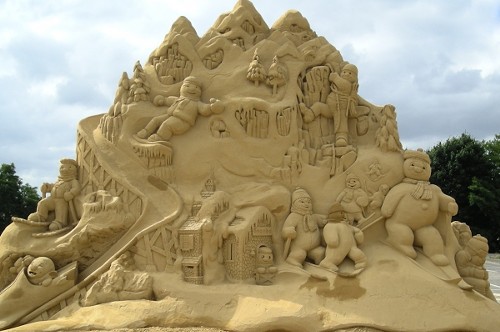Utah Arts Fest: Ted Siebert Sand Sculpture
Finding beauty in temporary moments
By Brian Staker @stakerizedAn arts
festival, by nature, is a temporary phenomenon—a celebration of the
artistic impulse that lasts only a few days, in which a few city blocks
are set aside for art on display and in process of being created, then
the space returns to its mundane routine afterward. This year, the Utah
Arts Festival brings an art form so singular and so temporary that it
doesn’t initially come to mind when you think of the wide array of art
forms and genres that usually take center stage at a festival: sand sculpture. It’s an
art form more reminiscent of childhood play and idle recreation time
than making profound statements.
And
Ted Siebert is no ordinary sand sculptor. Working with The Sand
Sculpture Company, which he founded in 1986 in Woodstock, Ill., he’s
constructed hundreds of works of sand art all over the world—and as
co-captain of the team Totally In Sand, has broken the Guinness orld
Record for the longest and tallest sand sculptures numerous times. The
team’s tallest clocked in at 24 feet. He is listed in the book The
Sculpture Reference as one of the leading contemporary sculptors. His
company has produced educational videos and has been featured on
television and magazines nationally; Siebert has written several other
books, and holds the titles of World, North American, U.S. and Canadian
national champion in the field. He was featured on the TV reality show
Sand Blasters about sand sculpting on the Travel Channel in 2006 and
2007. And it’s not his first time here, either: He erected a sand
sculpture for the Utah Arts Festival in 2002.
Siebert’s
initial foray into the art world was in painting, and after college he
worked as a book illustrator. But he had always been interested in sand,
and while studying in Seattle, entered the annual sand-sculpture
competition at Cannon Beach, Ore. “As a team event, it taught a lot of
interpersonal dynamics,” he says. The publisher he worked for hired him
to write a book on the subject, and that experience opened up his eyes
to the possibilities for the art form.
Working
in sand on the scale he does requires a team. These aren’t ordinary
sand castles, but can include everything from fantastical creatures to
indigenous flora and fauna. For the Utah Arts Festival, he is carving a
flamenco dance scene. “Working in sand is great in that it carves
extremely fast and compact well enough that you can carve just about
anything within reason,” he says. “I try to find the best sand, and that
is sand that has a lot of silt in it.”
He starts by locating good sand in the locale where the piece will be constructed. In this case, the festival sent him two samples of sand from local companies, and he selected his material from Geneva Rock Products. Then he packs the sand inside wooden boxes with a machine, removes the box top and carves from the top down. He says there’s “no show,” but spectators find his team’s process endlessly entertaining. “People are fascinated watching the process, and I think that’s twofold,” Siebert says.
“Everyone
at some point in their lives has built a sand castle, and the work of
art is temporary and could collapse at any time.”
The
festival was looking for a chance to ask this unusual artist to return,
but had problems with the Library Square site until it was reconfigured
in 2011 to make more room for such a demonstration, which will be on
the north end of 200 East, near 400 South (the site of glassblowing
demonstrations in 2011). The City Parks Department will help dispose of
the sand for use at its golf courses and other similar sites, and thus
the material is recycled and given further life.
Siebert
still sculpts in wood and clay and uses oil paints, but his sense of
craftsmanship is no less in this transient medium. It’s part sport, part
childlike pastime and part art form as demanding in technique as
any—and as worthy of admiration and acclaim—when you put the amount of
detail into it that he does.
“The temporary nature of our work seems so odd for some people, but it
is the sense of accomplishment you get when you build something with
your own hands and out of something that clearly doesn’t want to stick
together in its natural state,” he says.
This
art form—in all its playfulness, in its painstaking attention to detail
and, finally, completion in the form of returning to its original
formless state—is also a metaphor for life itself: “You do it for the
beauty of the moment.”
TED SIEBERT: SAND SCULPTURE
Utah Arts Festival
200 E. 400 South
801-322-2428
June 21-24
Festival admission, $5-$10, $30 for weekend
UAF.org
More by Brian Staker
-
Live Music Picks: April 12-18
Judas Priest, The Residents, Clownvis Presley, The Breeders and more.
- Apr 11, 2018
-
Loving the Alienation
Helios Creed and Chrome continue making iconoclastic music for outcasts.
- Mar 28, 2018
-
Live Music Picks: March 22-28
U.S. Girls, Ed Schrader’s Music Beat, Hell’s Belles, Columbia Jones and more.
- Mar 21, 2018
- More »



